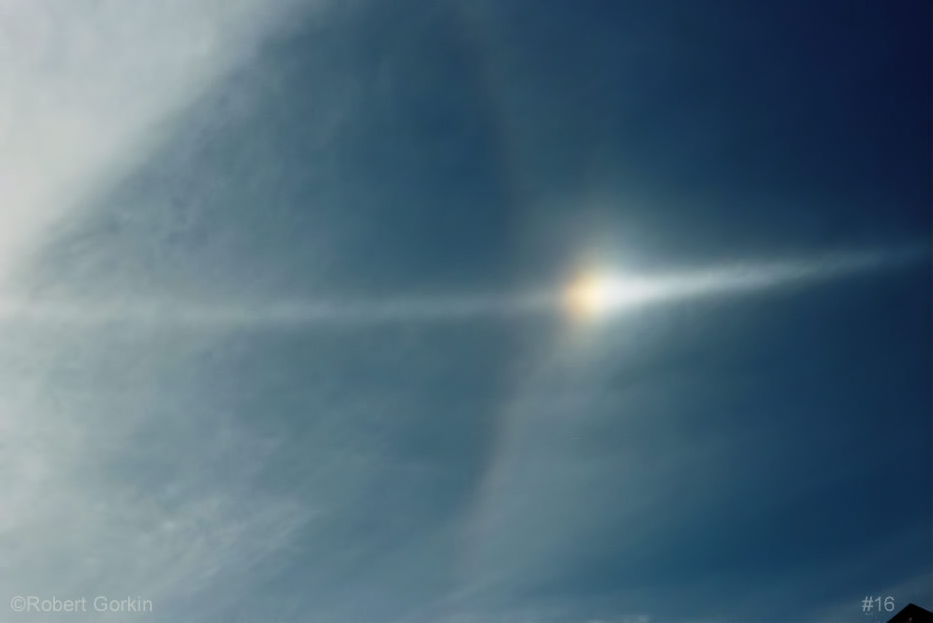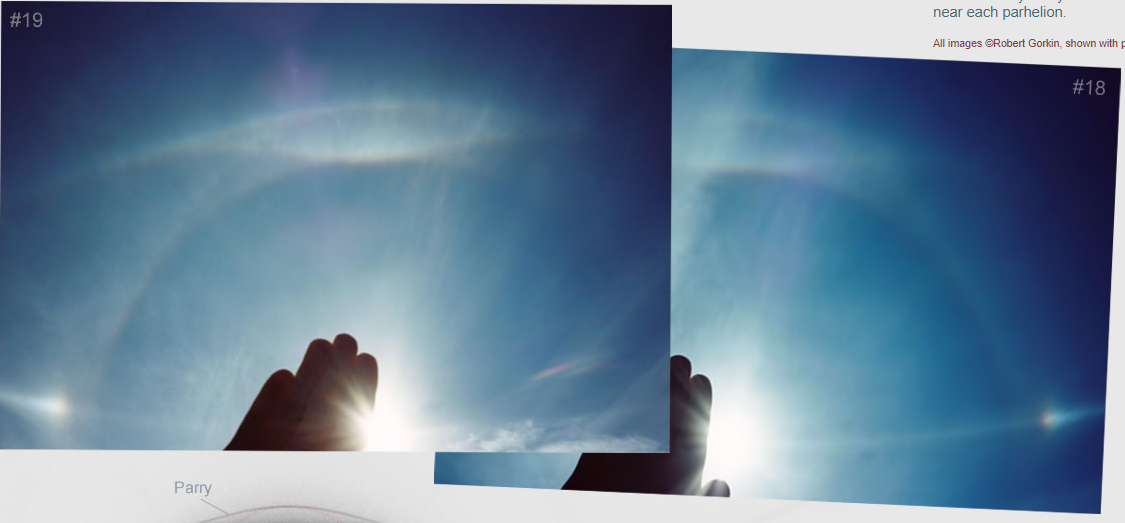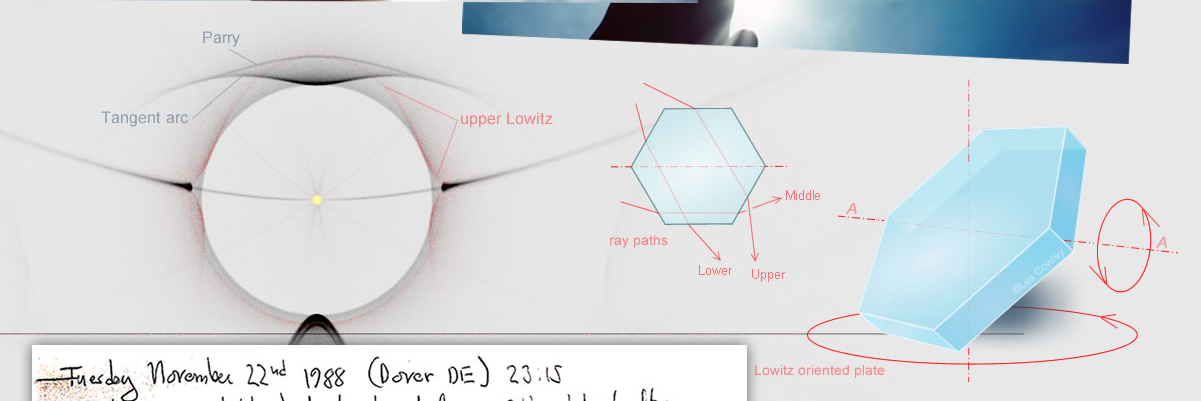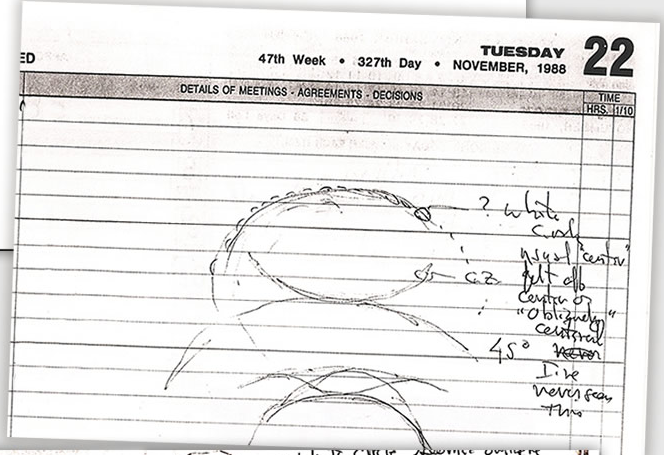OPOD - 1988 Lowitz Display, Delaware, USA
OPOD - 1988 Lowitz Display, Delaware, USA
In November 1988, an extraordinary atmospheric optics event known as the Lowitz Display was meticulously recorded by Robert Gorkin in Dover, Delaware, USA. Gorkin's images from this event are the earliest known documentation of the three Lowitz arcs, which have generated significant controversy in the scientific community. The existence of these arcs was doubted for many years due to the absence of photographic evidence, even from prime halo observing locations such as the Arctic and Antarctic. However, theoretical investigations continued to explore the possibility of their formation.
It was established that the Lowitz arcs might be formed by plate crystals with a rotation axis parallel to a large hexagonal face. In 1979, Mueller, Greenler, and Mallmann used computer ray tracing to predict that crystals with a 'Lowitz axis' passing across a crystal diagonal would produce three types of Lowitz arc: an 'upper,' 'lower,' and 'middle.' Gorkin's images from 1988 provide early visual evidence of these arcs, although the middle arc remains elusive and challenging to capture.
One of Gorkin's images shows the lower Lowitz arc, which stretches down from the sundog towards the 22° halo. Another fainter arc extends upwards to the 22° halo, confirming the predicted upper arc. These arcs sometimes overlay the 22° halo, causing a weakening of the halo opposite the parhelion. Additionally, there is a third predicted Lowitz arc, the middle arc, which appears to extend nearly vertically through the parhelion.
When the sun is less than approximately 30° high, the best place to search for an upper Lowitz arc is above the 22° halo rather than near the sundogs. In this location, it crosses the upper tangent arc and becomes tangent to the Parry arc. Gorkin's images clearly show the upper Lowitz arc in this position, as well as the arcs near each parhelion.
The 1988 Lowitz Display was not only notable for the presence of the Lowitz arcs but also for several other atmospheric optical phenomena. These included an upper Parry arc, supralateral arc, circumzenithal arc, and possibly a helic arc, which was an early recording of this particular phenomenon. The parhelic circle extended around the sky to a bright 120° parhelion.
In terms of image processing, R. Eric Young scanned Robert Gorkin's original negatives and Les Cowley applied mild filtering to reduce film grain. The only further manipulation involved slight adjustments to contrast and color balance using Photoshop's linear levels control.
Overall, the 1988 Lowitz Display in Delaware, USA, captured by Robert Gorkin, provided crucial visual evidence of the elusive Lowitz arcs. These images contributed significantly to our understanding of the formation and characteristics of these unique atmospheric optical phenomena. The event also showcased other stunning halo displays, adding to the scientific knowledge of atmospheric optics.

1988 Lowitz Pictures
Robert Gorkin meticulously recorded this ice halo display at Dover, Delaware, USA on Tuesday, November 22, 1988 13:15 to 14:00 EST. At left is one of 24 images recorded on two film rolls.
His images are the earliest known ones of the three Lowitz arcs.
Lowitz arcs have generated more controversy than any other halo. One arc was first sketched by Tobias Lowitz in St Petersburg 1790. Subsequent sightings were sparse indeed. The absence of photographs, even from superb halo locations like the Arctic and Antarctic, led to serious doubts about their existence through to the late 1990s and in some cases beyond.
That did not stop theoretical investigation. It was established that they might be formed by plate crystals with a rotation axis parallel to a large hexagonal face. In 1979 Mueller, Greenler and Mallmann used the new tool of computer ray tracing to predict that crystals with a 'Lowitz axis' passing across a crystal diagonal would produce three types of Lowitz arc, an 'upper', 'lower' and 'middle'. Gorkin's 1988 images are perhaps the earliest that show them - although the middle arc is, as always, rather elusive.
In the top image (.16) the lower Lowitz arc, the only one recorded by Lowitz, stretches down from the sundog towards the 22� halo. A fainter arc extends upwards to the 22� halo, the predicted upper arc. In places the two arcs overlay the 22� halo and their presence, as here, is often best indicted by weakness of the 22� halo opposite the parhelion.
There is possibly also the third predicted Lowitz arc, the middle, extending nearly vertically through the parhelion. This is slightly more evident in the stack of three images at left. Mouse over to see the matching ray tracing.
When the sun is less than around 30° high the best place to search for an upper Lowitz arc is above the 22� halo rather than near the sundogs. There, it crosses the upper tangent arc and becomes tangent to the Parry arc. Gorkin's images below (.19,18 ) show it clearly. They also show the arcs near each parhelion.
All images ©Robert Gorkin, shown with permission.

A HaloSim ray tracing for a 27º high sun overlain by three stacked images (.14-16). Mouse over to toggle the images on/off.
The simulation Lowitz crystals were regular hexagonal plates with classical Lowitz orientation i.e. full 360º rotational positions about the Lowitz axis. The plates were thick (c/a = 0.5) in order to show up the middle Lowitz arc. The bright and tall 120º parhelion (lowest image) suggests thick (or triangular aspect) plates.



Robert Gorkin's notes of the observation written at the time in his day book and partly during the same evening.
The (evening) references (lowest page) are to Robert Greenler's ray tracing simulation predictions in "Rainbows, Halos and Glories".
The display was notable enough besides the Lowitz arcs with an upper Parry arc, supralateral arc, circumzenithal arc and possibly a helic arc - an early recording of the latter. The parhelic circle extended around the sky to a bright 120º parhelion.



A bright and vertically elongated 120º parhelion to the east. The parhelic circle stretches sunwards.
Image processing:
R. Eric Young of Young's Studio scanned Robert Gorkin's original negatives to 1800x1204 24bit TIFF files. Les Cowley mildly filtered the TIFFs to reduce film grain. The only further manipulation was to slightly adjust contrast and colour balance using the linear levels control in Photoshop.
References:
Lowitz, T., Nova Acta Acad Sci Imperialis Petropolitanae, 8, 384 (1794)
Mueller J R, Greenler R G and Mallman A J., JOSA 69, 1103 (1979) and citations there.
Greenler, Robert, "Rainbows, Halos and Glories", Cambridge, 1980
Riikonen M., Cowley L., Schroeder M., Pekkola M, �hman T. and Hinz C., Weather, 62, 252-6 (2007)
Note: this article has been automatically converted from the old site and may not appear as intended. You can find the original article here.
Reference Atmospheric Optics
If you use any of the definitions, information, or data presented on Atmospheric Optics, please copy the link or reference below to properly credit us as the reference source. Thank you!
-
<a href="https://atoptics.co.uk/blog/opod-1988-lowitz-display-delaware-usa/">OPOD - 1988 Lowitz Display, Delaware, USA</a>
-
"OPOD - 1988 Lowitz Display, Delaware, USA". Atmospheric Optics. Accessed on April 19, 2024. https://atoptics.co.uk/blog/opod-1988-lowitz-display-delaware-usa/.
-
"OPOD - 1988 Lowitz Display, Delaware, USA". Atmospheric Optics, https://atoptics.co.uk/blog/opod-1988-lowitz-display-delaware-usa/. Accessed 19 April, 2024
-
OPOD - 1988 Lowitz Display, Delaware, USA. Atmospheric Optics. Retrieved from https://atoptics.co.uk/blog/opod-1988-lowitz-display-delaware-usa/.